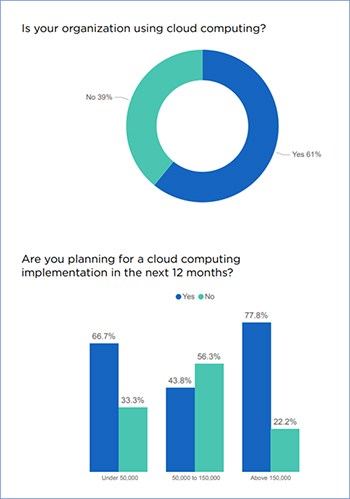How are cities using the cloud?
March 06, 2022 by Meredith Trimble

In recent years, the cloud has become an increasingly popular choice for local governments looking to modernize and improve operations. A 2020 FedRAMP survey with responses from 300 state and local government information technology decision-makers found that 9% of states, counties, and cities were using all cloud-based systems and solutions while 93% had at least some systems in the cloud.
Accelerating the Transition
Many cities took the opportunity of pandemic-driven disruption to transition, or continue a transition, from on-premises to cloud-based technology solutions. “We had a goal of being premise-agnostic by 2022,” said Hanna Pickering, IT director, Portland, Maine. “Because of COVID-19 we had to meet that goal last year. If our productivity tools had not been in the cloud, it would have been a much harder transition for us. We saw some real benefits there.”
New Survey Results
As part of CompTIA’s 2021 National Survey of Local Government Cybersecurity and Cloud Initiatives, the National League of Cities (NLC) surveyed city leaders to get additional insight into how cities are approaching cloud computing. The results, detailed in a new paper, “Cities in the Cloud: What City Leaders Need to Know About Cloud Computing,” include responses from 46 information technology professionals in cities across the U.S. on their approaches to the cloud and their perceptions of its opportunities and obstacles. This new research shows cities are embracing and using cloud-enabled solutions.
For example:
- More than 60% of respondents stated their cities are using cloud-based solutions
- Two-thirds of cities with populations of less than 50,000 residents are planning additional cloud investments

Most respondents’ cities are using cloud-based technology solutions for a few key operations: website hosting, data backup and recovery, and internal operations like email, calendars, and communication.
Respondents are also primarily using cloud-enabled solutions in areas such as information technology, human resources, code enforcement, community engagement, building permitting, and finance.
Cities with populations of more than 150,000 residents are most likely to use the cloud for information technology and community engagement (both 78%). Cities of 50,000 to 150,000 use the cloud for information technology, human resources, and finance (all 38%). Cities with fewer than 50,000 residents use the cloud for information technology (62%).
Future Investments
Thirty-nine percent of respondents expect to implement additional cloud-based solutions in the next 12 months. In terms of cost, 70% indicated their organizational spending on cloud resources was efficient. This aligns with known cost savings associated with the cloud, including:
- Lower IT operational costs
- Lower IT maintenance costs
- More predictable overall costs
In addition, an impressive 85% felt either confident or very confident in the security of their cloud services. Enhanced cybersecurity safeguards and better disaster recovery are reasons leaders cited for ongoing cloud investments.
The capabilities and functionality of cloud-based solutions are agile and continually expanding, making them more attractive options for cities looking to better meet current and future challenges